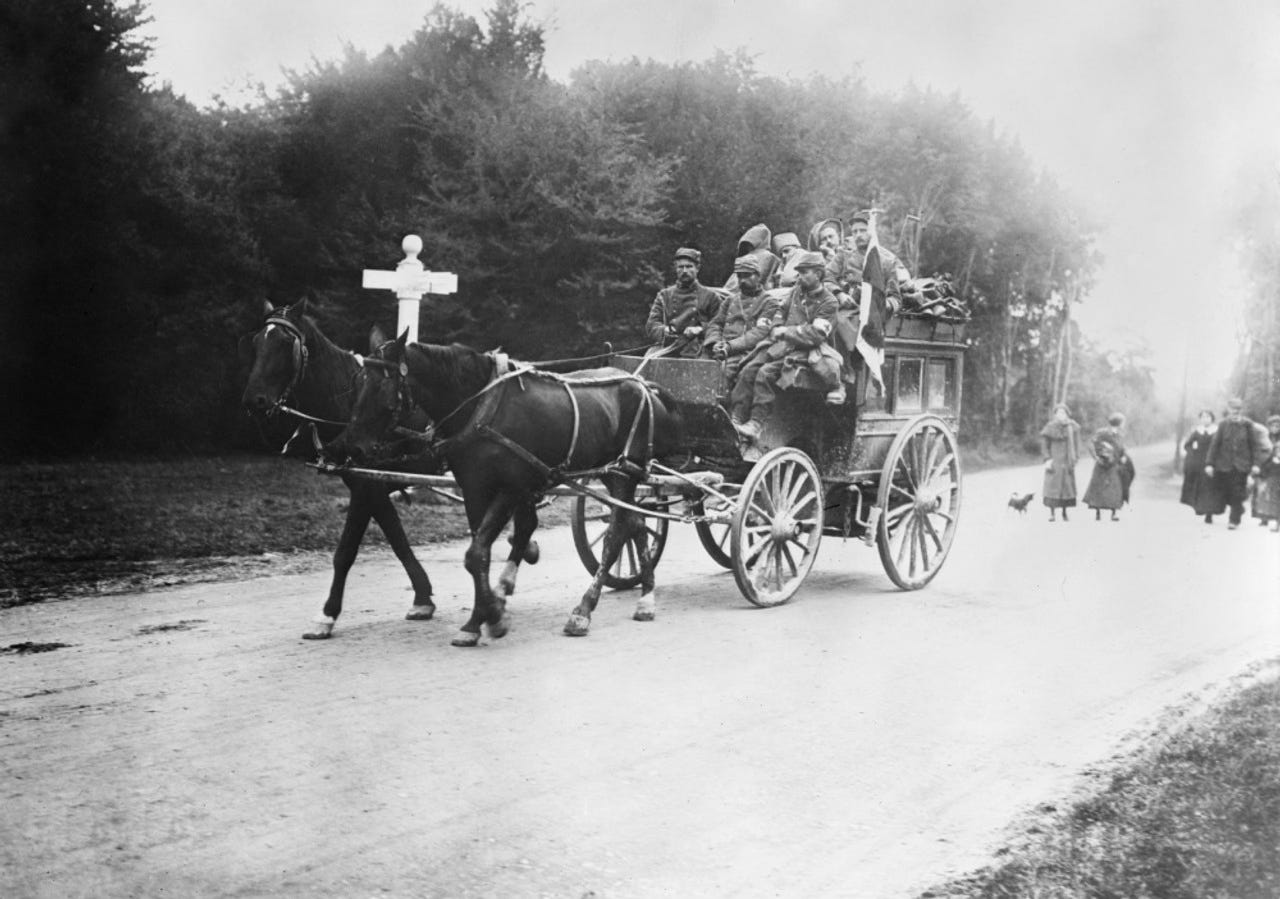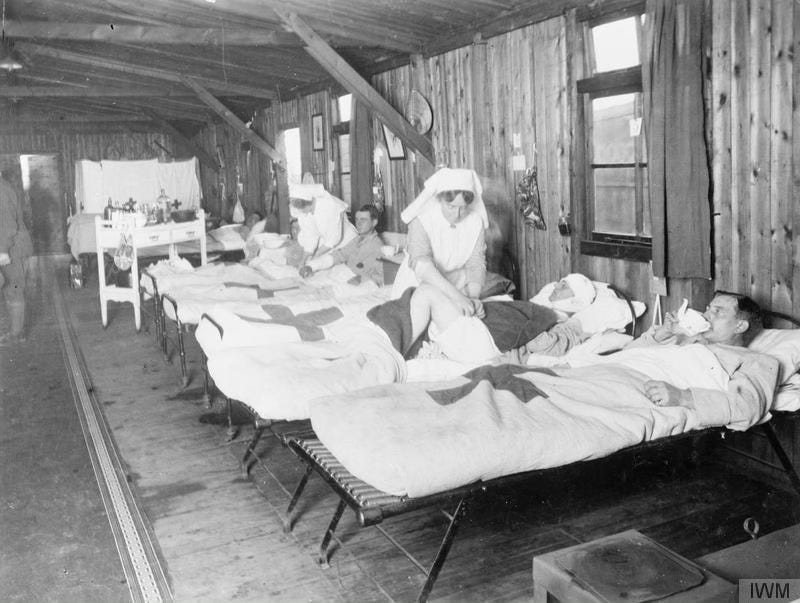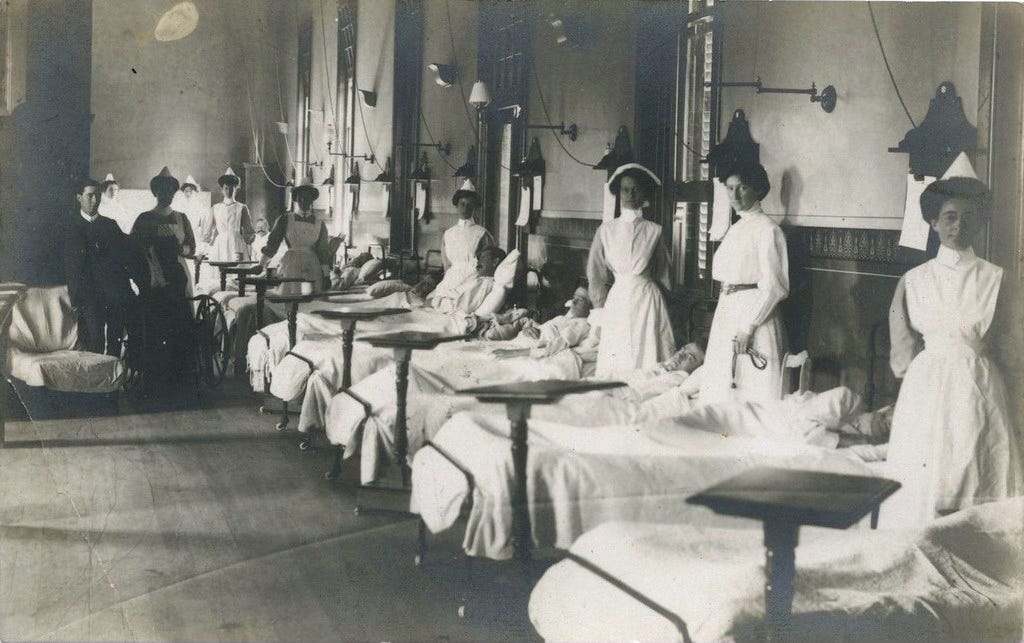Blood & Mud: Allied medical treatment in the First World War
A wounded Allied soldier had a 94% survival rate if he got out in time
“This was the home of the great god Pain, and for the first time I looked through a devilish chink into the depths of his realm.”
- Ernst Junger, Storm of Steel, 1915
The scale of suffering in the Great War is hard to imagine more than 100 years on. Between 22 million and 30 million were killed, making it one of the deadliest conflicts in human history. But twice that number were wounded, and these were mass casualty situations the world had rarely seen before then. The war’s brutal combination of trench warfare and industrialized weaponry resulted in new kinds of life-altering injuries. Artillery barrages, machine guns, and poison gas created casualty numbers that dwarfed those of previous conflicts. Soldiers lived in muddy, bacteria-filled ditches surrounded by rats, flies, and corpses. Infection claimed hundreds of thousands of lives.
However, as the war progressed, rapid advancements in battlefield medicine saved lives. The survival rate for a wounded soldier who received medical attention soared from 60% in 1914 to 96% in 1915, a year later. The evolution of Allied medical care during the Great War includes the way care was organized, from the first moment a soldier was collected by stretcher bearers to his processing through various field ambulances and casualty clearing centers. Advancements in blood transfusions, prosthetics, infection treatment, and the recognition of psychological trauma laid the foundation for the modern medicine we enjoy today.
Transformative advancements in Allied medical care during this war went through several stages. It’s important to note that Allied medical care leapfrogged past German medical care, to the point where a British or Australian or French soldier’s survival rate was vastly higher than that of a German soldier. Austrian, Italian and Russian soldiers were served pitifully by their outdated and overstrained medical systems, and they suffered among the highest casualties as a result.
The early challenges of battlefield medicine would be considered primitive to us today, although they were in line with what experts knew at the time, and they were much more advanced than during the US Civil War only 50 years earlier. Still, survival was dire in the early stages of the war. Then, key innovations revolutionized care, such as blood transfusions and triage systems. The journey a wounded soldier took from the battlefield to the hospital bed was carefully organized and played a major role in saving lives. Once a soldier was carried out of No Man’s Land, he was in the care of a well-oiled machine of medical recovery. The final stage of medical care in this war was perhaps the least understood: psychological trauma. The destruction of men’s minds in the muddy trenches of the western front would be studied intensely after the war and lead to some major revelations in the fields of psychology and neuroscience.
Early war medical practices
Pain and suffering for all
”“Our duty is to go forward into this valley of the shadow of death with courage and faith – with courage to suffer, and faith in God and our country”
Medical science had come a long way by 1914. Blood types had been discovered in 1901, vitamines and nutrients in 1906, and viruses in 1910. Every practicing doctor and nurse knew about infection and bacteria. Life expectancy in England had risen from 47.8 years for men and 52.1 years for women to 61.2 years and 66.8 years, respectively, in just over a decade. A large part of the miracle of medical science in the first years of the 20th Century had to do with communication. Globe-spanning telegraphs allowed researchers to share their findings with their colleagues, no matter where in the world they were. Scientists in Germany could publish their findings in an American journal, while a Russian researcher could bounce ideas off of his Australian counterpart.
But none of the great medical advancements of the day were ready for the types of horrendous wounds, or the sheer number of them, that would flood field hospitals in 1914. The beginning of the Great War was like a sudden untangling of a web made of elastics. The Austro-Hungarian Archduke Franz Ferdinand was assissinated in Sarajevo by a Serbian nationalist. Austria began a punitive war on Serbia as a result. Russia came to its fellow Slav’s aid and declared war on Austria. Germany, in an alliance with Austria, declared war on Russia. France, in an alliance with Russia, responded by declaring war on Germany, who immediately invaded Belgium and swept around the French border to invade the country from the north, prompting a declaration of war by the United Kingdom.
The war was one of movement in that first month, mainly of an enormous German army marching south into northern France, and the French army retreating in disarray. But mass casualties with horrendous wounds were already being noted.
“One hopes that it will be a bullet that gets you, as then you will be able to walk back to the waiting ambulances, provided the good will of the Lord that it does not kill you outright. But even that would be a better fate than to be wounded by a shell. To have one’s bones torn out of one’s legs, leaving only dangling and shredded flesh, to die screaming in a field for hours. Lord protect me from such a fate!”
- A French sergeant in a letter to someone named “Robert”
Modern artillery was particularly nasty. A prefabricated shell consisting of a canister packed with explosives and lead balls was loaded into the breech of a cannon. Field guns fired shells with the propellant already built into its base, so the gun could be rapidly fired and reloaded. Howitzers, larger and with greater range, that fired enormous shells high into the air to rain down on its target in an arc, mostly used bags of gunpowder packed in behind the shell.
The end result of these shells was the same. The casing exploded upon impact with the ground or at a predetermined height set by a fuse in the nose of the shell. Lead balls and jagged chunks of metal from the casing blasted through the air all around. The larger the shell, the further and faster the pieces flew. This shrapnel tore ghastly holes in human flesh. It pulverized bone and muscle. It carried away limbs. Men simply disintegrated. Whereas high-powered rifle bullets left a somewhat clean entry and exit hole, artillery shrapnel wreaked chaos on the human body.
The small ambulance corps attached to the British Expeditionary Force (BEF) in this opening phase of the war proved to be little for the task. The English army’s first engagement with the Germans was at Mons, and there, concentrated British rifle fire massacred the advancing Germans. That is, until German artillery was brought in to bear on the English troops, entrenched along a canal. Casulties among the Tommies (English soldiers) were more than the ambulances could handle.
No surgeon in 1914 was prepared for these wounds. As the English wounded were bounced along on horse-drawn carts or on early-model trucks that did not have shock absorbers, they writhed in pain. They had broken limbs and gaping holes in their bodies. There was no frontline anaesthetic for them. Of the 1,600 wounded Brits evacuated from Mons, roughly 700 died in agony on the journey to a field hospital.
The survival rate skyrockets
A system that saved lives
It wasn’t until after the battle of the Marne, when the Entente, France and England, stopped the Germans at the gates to Paris, that the static trench lines we’ve come to associate with the war allowed for better first aid. The French and British armies, including the Dominion armies of Canada, Australia, New Zealand, and South Africa, would all establish the same basic model for evacuating the wounded and ensuring their care and survival.
This model would be in place by 1915, in time for the deadly Second Battle of Ypres and history’s first use of chemical gas as a weapon. It worked like this.
Each battalion had several teams of stretcher bearers. These were four men, carrying between them a stretcher made up of two long wooden poles between which hung suspended a thick canvas sheet. There were straps to hold the wounded man in place along this sheet. These stretcher bearers would rush to gather a wounded man upon hearing cries for help.
The stretcher team would carry the wounded man back to their trench, where a front line aid station was set up. Every battalion had one, and it contained several medical orderlies. In future wars these orderlies would be known as medics and would advance with the battalion, but in the trenches of the Great War there was no need. They could do a much better job in the trench.
They would stabilize the wounded victim so he would survive long enough to reach his next destination: a casualty clearing station (CCS). He would be taken there by ambulance, which was usually horse-drawn in the first year of the war but mostly motorized by 1916. Several other wounded men would accompany him, and a medical orderly would oversee their safe travel.
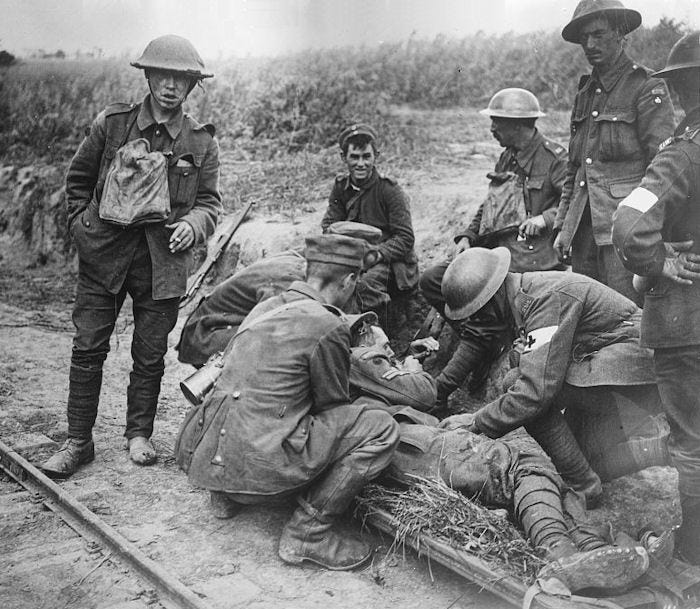
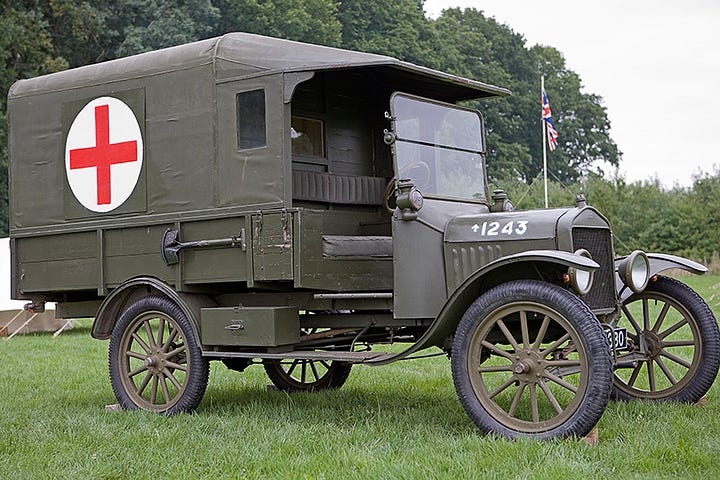
The CCS’ were not far from the front, only a few miles. They often came under artillery fire. In some battles, they were nearly overrun, particularly a Canadian CCS during Second Ypres in 1915, and a large French CCS was completely overrun in the German’s final offensive of the war in 1918.
The CCS was staffed with surgeons and nurses, including many women. This was as close as women got to the front in the First World War, and more than 400 lost their lives to German shelling during the war. The Red Cross, the Hospitaliers, and the Sisters of Mercy (established by Florence Nightengale during the Crimean War) supplied the majority of doctors and nurses.
Most of these stations were set up inside buildings that had been commandeered for the role. Gymnasiums, schools, and warehouses were used extensively. Tents were used in rare cases, particularly near the end of the war.
It was at the casualty clearing station that men were either saved or perished. While the battalion aid station performed rudimentary triage, it was impossible in those conditions to tell the full extent of a soldier’s wounds, especially as shells tended to pulverize flesh. The CCS was much better able to triage. But even if a wounded soldier seemed as if he would survive when cleared from the frontline aid station, his condition could deteriorate rapidly by the time he reached the CCS. The staff worked miracles, and they were well-supplied with the most advanced surgical equipment of the day. But it was impossible to save everybody, and one of the first grim sights to meet a wounded man as he was unloaded from the ambulance was a long row of corpses next to the station, covered by tarps, awaiting burial.
If a man survived long enough to receive care at the CCS, he had a good chance of surviving his wounds. They had plenty of chloroform and other anaesthetics to help with pain and shock. There were none of the raw amputations of a generation ago. Men were put to sleep for such grim work. Infections were under control. Gangrene was rare in allied clearing stations, and it wouldn’t be until the Spanish Flu of 1918 that viral infections ever became a cause for concern.
A wounded man could expect to spend up to two weeks at a CCS before being shuttled to a hospital for recovery far behind the lines. Once his flesh had been patched up and infections rendered under control, an ambulance would take him to a train platform, where he would join hundreds of other wounded men in a hospital car. Most ended up in Paris or the south of France. Some Englishmen (and their Dominion troops) would be sent to England for recuperation but this was rare.
Hospital care was exceptional for the time. Clean sheets, fresh food, and attentive medical staff ensured a nearly 100% survival rate. Best yet, there were no shells. Doctors would ascertain how long a man needed to stay, and whether or not he was fit to be returned to combat. A bullet wound through the shoulder would most likely send a man back to his unit within a couple of months. An amputated limb, on the other hand, was a ticket home.
This vast network of care was established fairly early on. Once the trenches were established, it seems the Entente powers put a lot of thought and effort into their medical system. Much more than the Central Alliance powers.
“I have been made prisoner, of which I am most dishonored, but I am alive and well thanks to the good doctors here, of which I am most surprpised.”
- Corporal Albrecht Duerr of the 14th Royal Saxon (179th Infantry) Regiment, in a letter home
The psychology of war
One haunting aspect of war was little understood at the beginning. The destruction it could cause to the psychology of someone forced to endure three days of artillery bombardment, of living next to a field of corpses, rats scurrying about with chunks of human meat in their mouths, of the horror of sinking in a corpse-filled mud hole…all of it broke men’s minds.
The physical concussion of exploding shells caused what we’ve come to know as “shell shock,” and it could leave lasting brain damage. Men’s minds were physically pulverized inside their skulls, rendering them brain damaged for life.
But even men who escaped unharmed carried deep scars in their minds. And while some famous stories of executions of frontline soldiers for cowardice are told, the truth is much more nuanced. Pyschology was a new and evolving field of medical science by 1914, and the war provided much opportunity for studying the effects of battle on the human psyche. England, for one, recognized psychological trauma early on, and had a policy of removing men who were breaking down from the front and giving them several weeks of rest and relaxation before returning them to their units.
Most battalions in the French and British armies (and their respective colonies and dominions) rotated out of the trenches every four days, and would spend between four and seven days behind the lines. It was considered essential for their psychological well being.
Severe victims of trauma were decommissioned. They would either be sent home or interned in a mental hospital, where much extremely valuable study was made.
Footage of a French victim of psychological trauma from the war reacting to a military cap, filmed in 1918 after the war’s end.
The medical system set up by the Entente (later the Allies) became a model for all future armies, even today. The tactical methodology has changed to meet the demands of the individual theater, but the concept is the same. Whether men were carried out by stretchers, treated on a beach by a medic under fire, or flown out in a helicopter, the goal has been to process the wounded through a rigorous medical system designed to save lives. From the clearing station to the field hospital to the recovery hospital, the medical system of the First World War revolutionized how wounded soldiers were saved.





